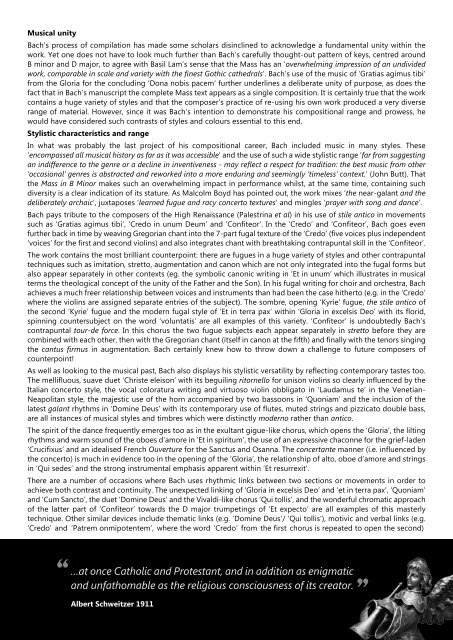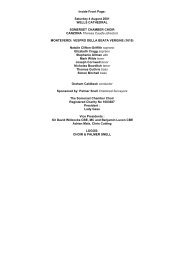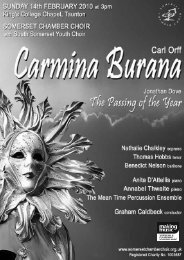Click here to view the concert programme - Somerset Chamber Choir
Click here to view the concert programme - Somerset Chamber Choir
Click here to view the concert programme - Somerset Chamber Choir
You also want an ePaper? Increase the reach of your titles
YUMPU automatically turns print PDFs into web optimized ePapers that Google loves.
Musical unity<br />
Bach’s process of compilation has made some scholars disinclined <strong>to</strong> acknowledge a fundamental unity within <strong>the</strong><br />
work. Yet one does not have <strong>to</strong> look much fur<strong>the</strong>r than Bach’s carefully thought-out pattern of keys, centred around<br />
B minor and D major, <strong>to</strong> agree with Basil Lam’s sense that <strong>the</strong> Mass has an ‘overwhelming impression of an undivided<br />
work, comparable in scale and variety with <strong>the</strong> finest Gothic ca<strong>the</strong>drals’. Bach’s use of <strong>the</strong> music of ‘Gratias agimus tibi’<br />
from <strong>the</strong> Gloria for <strong>the</strong> concluding ‘Dona nobis pacem’ fur<strong>the</strong>r underlines a deliberate unity of purpose, as does <strong>the</strong><br />
fact that in Bach’s manuscript <strong>the</strong> complete Mass text appears as a single composition. It is certainly true that <strong>the</strong> work<br />
contains a huge variety of styles and that <strong>the</strong> composer’s practice of re-using his own work produced a very diverse<br />
range of material. However, since it was Bach’s intention <strong>to</strong> demonstrate his compositional range and prowess, he<br />
would have considered such contrasts of styles and colours essential <strong>to</strong> this end.<br />
Stylistic characteristics and range<br />
In what was probably <strong>the</strong> last project of his compositional career, Bach included music in many styles. These<br />
‘encompassed all musical his<strong>to</strong>ry as far as it was accessible’ and <strong>the</strong> use of such a wide stylistic range ‘far from suggesting<br />
an indifference <strong>to</strong> <strong>the</strong> genre or a decline in inventiveness - may reflect a respect for tradition: <strong>the</strong> best music from o<strong>the</strong>r<br />
‘occasional’ genres is abstracted and reworked in<strong>to</strong> a more enduring and seemingly ‘timeless’ context.’ (John Butt). That<br />
<strong>the</strong> Mass in B Minor makes such an overwhelming impact in performance whilst, at <strong>the</strong> same time, containing such<br />
diversity is a clear indication of its stature. As Malcolm Boyd has pointed out, <strong>the</strong> work mixes ‘<strong>the</strong> near-galant and <strong>the</strong><br />
deliberately archaic’, juxtaposes ‘learned fugue and racy concer<strong>to</strong> textures’ and mingles ‘prayer with song and dance’.<br />
Bach pays tribute <strong>to</strong> <strong>the</strong> composers of <strong>the</strong> High Renaissance (Palestrina et al) in his use of stile antico in movements<br />
such as ‘Gratias agimus tibi’, ‘Credo in unum Deum’ and ‘Confiteor’. In <strong>the</strong> ‘Credo’ and ‘Confiteor’, Bach goes even<br />
fur<strong>the</strong>r back in time by weaving Gregorian chant in<strong>to</strong> <strong>the</strong> 7-part fugal texture of <strong>the</strong> ‘Credo’ (five voices plus independent<br />
‘voices’ for <strong>the</strong> first and second violins) and also integrates chant with breathtaking contrapuntal skill in <strong>the</strong> ‘Confiteor’.<br />
The work contains <strong>the</strong> most brilliant counterpoint: t<strong>here</strong> are fugues in a huge variety of styles and o<strong>the</strong>r contrapuntal<br />
techniques such as imitation, stret<strong>to</strong>, augmentation and canon which are not only integrated in<strong>to</strong> <strong>the</strong> fugal forms but<br />
also appear separately in o<strong>the</strong>r contexts (eg. <strong>the</strong> symbolic canonic writing in ‘Et in unum’ which illustrates in musical<br />
terms <strong>the</strong> <strong>the</strong>ological concept of <strong>the</strong> unity of <strong>the</strong> Fa<strong>the</strong>r and <strong>the</strong> Son). In his fugal writing for choir and orchestra, Bach<br />
achieves a much freer relationship between voices and instruments than had been <strong>the</strong> case hi<strong>the</strong>r<strong>to</strong> (e.g. in <strong>the</strong> ‘Credo’<br />
w<strong>here</strong> <strong>the</strong> violins are assigned separate entries of <strong>the</strong> subject). The sombre, opening ‘Kyrie’ fugue, <strong>the</strong> stile antico of<br />
<strong>the</strong> second ‘Kyrie’ fugue and <strong>the</strong> modern fugal style of ‘Et in terra pax’ within ‘Gloria in excelsis Deo’ with its florid,<br />
spinning countersubject on <strong>the</strong> word ‘voluntatis’ are all examples of this variety. ‘Confiteor’ is undoubtedly Bach’s<br />
contrapuntal <strong>to</strong>ur-de force. In this chorus <strong>the</strong> two fugue subjects each appear separately in stret<strong>to</strong> before <strong>the</strong>y are<br />
combined with each o<strong>the</strong>r, <strong>the</strong>n with <strong>the</strong> Gregorian chant (itself in canon at <strong>the</strong> fifth) and finally with <strong>the</strong> tenors singing<br />
<strong>the</strong> cantus firmus in augmentation. Bach certainly knew how <strong>to</strong> throw down a challenge <strong>to</strong> future composers of<br />
counterpoint!<br />
As well as looking <strong>to</strong> <strong>the</strong> musical past, Bach also displays his stylistic versatility by reflecting contemporary tastes <strong>to</strong>o.<br />
The mellifluous, suave duet ‘Christe eleison’ with its beguiling ri<strong>to</strong>rnello for unison violins so clearly influenced by <strong>the</strong><br />
Italian concer<strong>to</strong> style, <strong>the</strong> vocal coloratura writing and virtuoso violin obbliga<strong>to</strong> in ‘Laudamus te’ in <strong>the</strong> Venetian-<br />
Neapolitan style, <strong>the</strong> majestic use of <strong>the</strong> horn accompanied by two bassoons in ‘Quoniam’ and <strong>the</strong> inclusion of <strong>the</strong><br />
latest galant rhythms in ‘Domine Deus’ with its contemporary use of flutes, muted strings and pizzica<strong>to</strong> double bass,<br />
are all instances of musical styles and timbres which were distinctly moderno ra<strong>the</strong>r than antico.<br />
The spirit of <strong>the</strong> dance frequently emerges <strong>to</strong>o as in <strong>the</strong> exultant gigue-like chorus, which opens <strong>the</strong> ‘Gloria’, <strong>the</strong> lilting<br />
rhythms and warm sound of <strong>the</strong> oboes d’amore in ‘Et in spiritum’, <strong>the</strong> use of an expressive chaconne for <strong>the</strong> grief-laden<br />
‘Crucifixus’ and an idealised French Ouverture for <strong>the</strong> Sanctus and Osanna. The <strong>concert</strong>ante manner (i.e. influenced by<br />
<strong>the</strong> concer<strong>to</strong>) is much in evidence <strong>to</strong>o in <strong>the</strong> opening of <strong>the</strong> ‘Gloria’, <strong>the</strong> relationship of al<strong>to</strong>, oboe d’amore and strings<br />
in ‘Qui sedes’ and <strong>the</strong> strong instrumental emphasis apparent within ‘Et resurrexit’.<br />
T<strong>here</strong> are a number of occasions w<strong>here</strong> Bach uses rhythmic links between two sections or movements in order <strong>to</strong><br />
achieve both contrast and continuity. The unexpected linking of ‘Gloria in excelsis Deo’ and ‘et in terra pax’, ‘Quoniam’<br />
and ‘Cum Sanc<strong>to</strong>’, <strong>the</strong> duet ‘Domine Deus’ and <strong>the</strong> Vivaldi-like chorus ‘Qui <strong>to</strong>llis’, and <strong>the</strong> wonderful chromatic approach<br />
of <strong>the</strong> latter part of ‘Confiteor’ <strong>to</strong>wards <strong>the</strong> D major trumpetings of ‘Et expec<strong>to</strong>’ are all examples of this masterly<br />
technique. O<strong>the</strong>r similar devices include <strong>the</strong>matic links (e.g. ‘Domine Deus’/ ‘Qui <strong>to</strong>llis’), motivic and verbal links (e.g.<br />
‘Credo’ and ‘Patrem onmipotentem’, w<strong>here</strong> <strong>the</strong> word ‘Credo’ from <strong>the</strong> first chorus is repeated <strong>to</strong> open <strong>the</strong> second).<br />
"<br />
…at once Catholic and Protestant, and in addition as enigmatic<br />
and unfathomable as <strong>the</strong> religious consciousness of its crea<strong>to</strong>r.<br />
Albert Schweitzer 1911<br />
"












